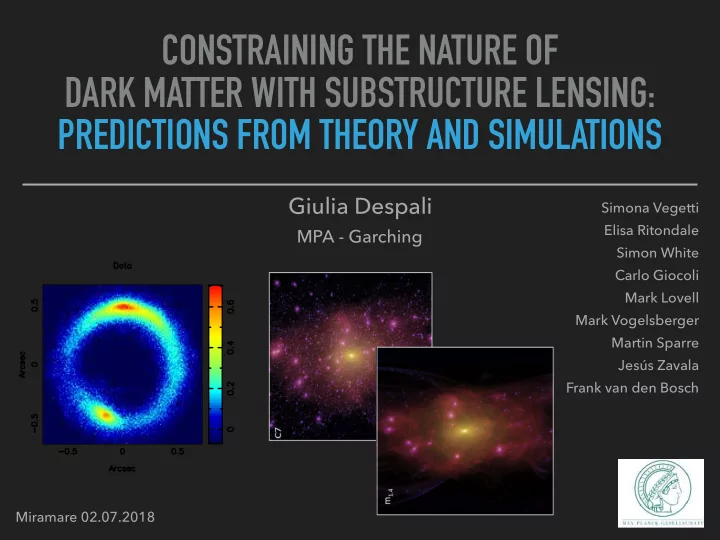

CONSTRAINING THE NATURE OF DARK MATTER WITH SUBSTRUCTURE LENSING: PREDICTIONS FROM THEORY AND SIMULATIONS Giulia Despali Simona Vegetti Elisa Ritondale MPA - Garching Simon White Carlo Giocoli Mark Lovell Mark Vogelsberger Martin Sparre Jesús Zavala Frank van den Bosch Miramare 02.07.2018
CONSTRAINING THE NATURE OF DARK MATTER WITH SUBSTRUCTURE LENSING: PREDICTIONS FROM THEORY AND SIMULATIONS Giulia Despali Simona Vegetti Elisa Ritondale MPA - Garching Simon White Carlo Giocoli Mark Lovell Mark Vogelsberger Martin Sparre Jesús Zavala Frank van den Bosch Miramare 02.07.2018
PREDICTIONS & NUMERICAL SIMULATIONS LINE-OF-SIGHT SIDM CONTRIBUTION (Despali, Sparre, Vogelsberger, Zavala, Vegetti et al in prep.) (Despali et al. 2018) impact of SIDM on the main halo how many LOS haloes we expect properties vs substructures in the main lens different distribution of Einstein predictions for CDM vs WDM rings? subhalo counts and profiles STERILE NEUTRINOS …see Elisa’ s talk! (Despali, Lovell, Vegetti et al. in prep.) subhalo counts from sterile neutrino WDM zoom simulations subhalo profiles, distribution and lensing power spectrum
PREDICTIONS LINE-OF-SIGHT CONTRIBUTION (Despali et al. 2018) lensing is sensitive to the whole mass distribution between the observer and the source Z z S Z M max n ( m, z ) dmdV N LOS = dz dz 0 M LOW ( z )
PREDICTIONS LINE-OF-SIGHT CONTRIBUTION (Despali et al. 2018) lensing is sensitive to the whole mass distribution between the observer and the source Z z S Z M max n ( m, z ) dmdV N LOS = dz dz 0 M LOW ( z ) “EQUIVALENT LINE-OF-SIGHT” + used to rescale the sensitivity + function at z ≠ z L + - - log M vir ( z ) = (0 . 41 x + 0 . 57 x 2 + 0 . 9 x 3 )
PREDICTIONS LINE-OF-SIGHT CONTRIBUTION (Despali et al. 2018) n W DM = (1 + γ M hm M − 1 ) β n CDM CDM WDM 3.3keV
PREDICTIONS LINE-OF-SIGHT CONTRIBUTION (Despali et al. 2018) n W DM = (1 + γ M hm M − 1 ) β n CDM CDM WDM 3.3keV current detection limit
PREDICTIONS LINE-OF-SIGHT CONTRIBUTION (Despali et al. 2018) n W DM = (1 + γ M hm M − 1 ) β n CDM CDM future observations WDM 3.3keV current detection limit
PREDICTIONS LINE-OF-SIGHT CONTRIBUTION (Despali et al. 2018) n W DM = (1 + γ M hm M − 1 ) β n CDM ratio subhaloes/line-of-sight CDM future observations WDM 3.3keV current detection limit the line-of-sight population dominates
PREDICTIONS & NUMERICAL SIMULATIONS SUMMARY LINE-OF-SIGHT SIDM CONTRIBUTION the LOS population dominates and provides cleaner constrains with better sensitivities we’ll be able to discriminate CDM/WDM we need to be careful with mass definitions STERILE NEUTRINOS
SIMULATIONS STERILE NEUTRINO DM 2 x 10 13 M ⦿ (Despali, Lovell et al. in prep.) 1 x 6 10 12 M ⦿ - 4 ETG-analogues selected from the Eagle simulation 1x 4 10 12 M ⦿ re-simulated with 2 models of 7.1 keV sterile neutrino : L 6 = 8, 11.2 - DMO and hydro versions - M SK [h -1 M O • ] 10 13 10 12 10 11 10 10 10 9 10 8 10 7 1000 Δ 2 = k 3 P(k) 100 CDM L 6 = 8.0, sin 2 (2 θ ) = 2.1x10 -10 L 6 = 9.0, sin 2 (2 θ ) = 8.1x10 -11 L 6 = 10.0, sin 2 (2 θ ) = 3.7x10 -11 L 6 = 11.2, sin 2 (2 θ ) = 2.1x10 -11 L 6 = 120.0, sin 2 (2 θ ) = 8.0x10 -13 10 1 1 10 100 200 k [h/Mpc] k [h/Mpc] z 0
SIMULATIONS same number of “luminous” STERILE NEUTRINO DM satellites - as in Lovell+16 difference in the “dark” population (Despali, Lovell et al. in prep.)
SIMULATIONS STERILE NEUTRINO DM (Despali, Lovell et al. in prep.)
SIMULATIONS STERILE NEUTRINO DM (Despali, Lovell et al. in prep.) Sterile Neutrinos “classic” WDM colder than the equivalent thermal relic WDM model n W DM = (1 + γ M hm M − 1 ) β n CDM
PREDICTIONS & NUMERICAL SIMULATIONS SUMMARY LINE-OF-SIGHT SIDM CONTRIBUTION the LOS population dominates and provides cleaner constrains with better sensitivities we’ll be able to discriminate CDM/WDM we need to be careful with mass definitions STERILE NEUTRINOS the properties of the main lens remain similar slightly colder than the equivalent thermal relic models fewer subhaloes
SIMULATIONS SELF-INTERACTING DM (Despali et al. in prep.) - 10 ETG-analogues selected from the Illustris simulation resimulated with SIDM + baryons - Vogelsberger et al. 2014
SIMULATIONS SELF-INTERACTING DM subhaloes have on average more cored profiles (Despali et al. in prep.) might be degenerate with WDM abundances similar subhalo population
SIMULATIONS SELF-INTERACTING DM (Despali et al. in prep.) the self-interaction influences the main halo profile
SIMULATIONS SELF-INTERACTING DM (Despali et al. in prep.) the self-interaction influences the main halo profile in the presence of baryons things are more complicated
SIMULATIONS SELF-INTERACTING DM (Despali et al. in prep.) the self-interaction influences the main halo profile in the presence of baryons things are more complicated
SIMULATIONS • Haloes from the Illustris and EAGLE main runs BARYONIC EFFECTS • M ~ 10 13 M ⦿ /h • z = 0.2, 0.5, 1 (Despali & Vegetti 2017)
PREDICTIONS & NUMERICAL SIMULATIONS SUMMARY LINE-OF-SIGHT SIDM CONTRIBUTION similar subhalo population the LOS population dominates but more cored sub profiles and provides cleaner constrains stronger effect on the main lens with better sensitivities we’ll be properties able to discriminate CDM/WDM ..depending on morphological we need to be careful with mass type? ..accretion history? definitions STERILE possible different Einstein radii distribution NEUTRINOS the properties of the main lens remain similar slightly colder than the equivalent thermal relic models fewer subhaloes …we need to be careful the baryonic physics effects!
Recommend
More recommend